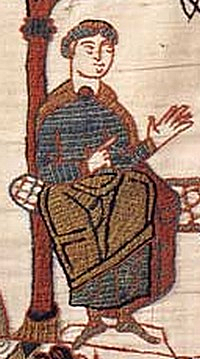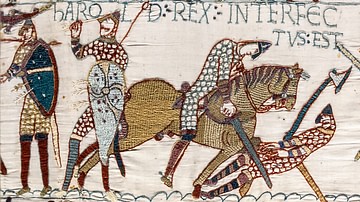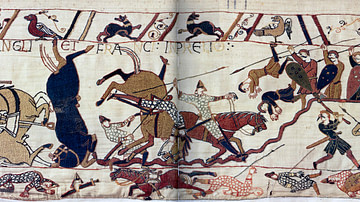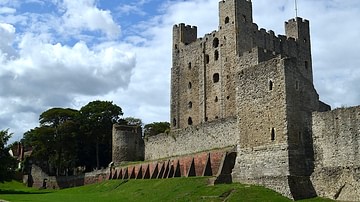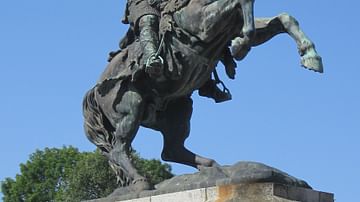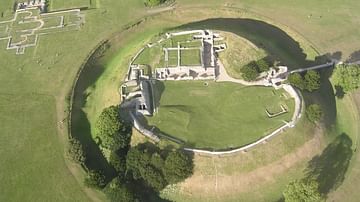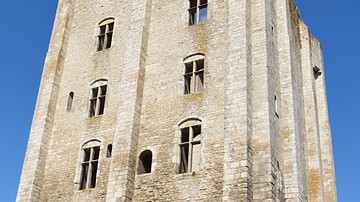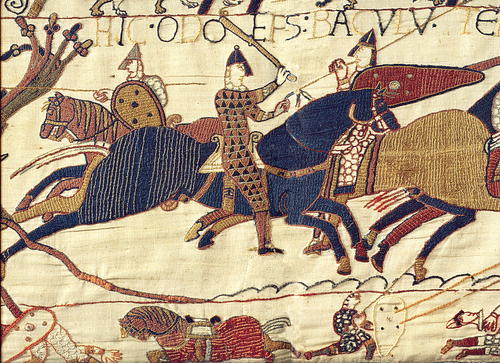
Odo of Bayeux (d. 1097 CE) was the bishop of Bayeux in Normandy and half-brother of William the Conqueror (r. 1066-1087 CE). After the Norman conquest of England in 1066 CE, Odo was given vast Anglo-Saxon estates and made, as the Earl of Kent, the second most powerful man in England after the king. The bishop-earl often acted as regent whenever William travelled to Normandy, and he is also the most likely candidate as the sponsor of the Bayeux Tapestry which, made between 1067 and 1079 CE, records the key events of the conquest and presents Odo in a prominent role in the drama. After the conquest, Odo fell out of favour with William, possibly by promoting himself as a candidate for Pope. Ambitious and immensely rich, Odo is portrayed variously as a talented and just ruler or a ruthless pillager of lands and monasteries, depending on which medieval source one favours.
Early Life
The year of Odo's birth is not known, although some historians suggest around 1030 CE, however, we do know he was the half-brother of William, Duke of Normandy, sharing the same mother, Herleve of Falaise, daughter of a wealthy merchant in Rouen. Odo's father was the Norman noble, Herluin de Conteville. William, in a highly unusual appointment, made his teenage brother bishop of Bayeux in 1049 CE. According to William of Poitiers (d. c. 1090 CE), often a flattering recorder of Norman deeds:
This Odo, bishop of Bayeux, was known to excel in affairs both ecclesiastical and secular. In the first place his goodness and prudence is witnessed by the church of Bayeux which with great zeal he set in excellent order and embellished, for though yet young in years he was more mature in capacity than older men. Next, he served all Normandy and added distinction to it. In synods concerned with the affairs of Christ, in councils where secular matters were discussed, he was outstanding both for his discernment and his eloquence. All were agreed that in munificence he had no equal in all of France.
(quoted in Allen Brown, 39)
Earl of Kent
Odo joined his brother William's invasion force to attack England in 1066 CE - indeed, he had been called on to supply 100 ships for it - and was even present at the Battle of Hastings of that year. As a bishop, his official role was to offer prayers for victory and provide moral support but he is depicted as actually in amongst the fighting in the Bayeux Tapestry, the visual Norman history of the conquest created shortly afterwards (see below). Odo was also in England as an able administrator, acting as William's Justiciar or agent of justice. It seems then that Odo was a highly unusual bishop and just as much interested in worldly affairs as ecclesiastical ones. It is interesting to note that even his own seal reflected this duality, depicting on one half a bishop holding his staff of office and a knight with a sword on the other.
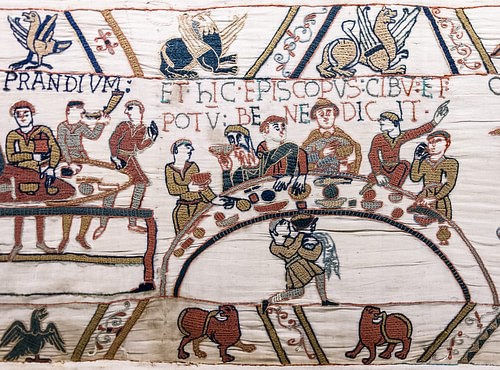
After the Battle of Hastings and following William's policy of redistributing his new lands once held by the conquered Anglo-Saxon elite into the hands of loyal Normans, Odo was made the Earl of Kent, a county which included the new castles at Dover and Rochester, and he was given great swathes of land elsewhere in England. Practically the second most powerful man in the country after King William, Odo would come to own vast estates across 22 counties. Most of Odo's lands, though, were in Kent, Buckinghamshire, Hertfordshire, and Lincolnshire, with the 1087 CE Domesday Book recording their value at a massive 3,000 pounds.
When William returned to his lands in Normandy, as he did frequently during his reign, Odo often acted as regent along with William FitzOsbern, Earl of Hereford. As Odo acquired many lands previously held by ecclesiastical institutions, especially monasteries, this may explain why medieval English chroniclers, themselves attached to such institutions, often paint a rather dark character portrait of Odo. It is perhaps worth noting, though, that records from the abbeys of St.Augustine, St. Albans, and Canterbury, and the bishopric of Rochester all actually praise the earl for his support and protection. In the typical ambiguity of the whole Norman conquest, the medieval Anglo-Saxon records paint Odo as a rapacious lord and the Norman sources present him as a landowner eager to promote peace and justice.
Odo & The Bayeux Tapestry
The famous Bayeux Tapestry is not actually a woven tapestry but an embroidered piece of multiple-banded linen fastened onto a backing cloth. Measuring 68.38 metres (224 ft) in length and 50 cm (20 inches) in width, it has 58 scenes of the Norman conquest of England and the events which led up to it. Odo has long been one of the prime candidates for the tapestry's sponsors or as the intended recipient of the finished work. This is because he features so prominently in the work itself. A second pointer is that the most likely place of the tapestry's production was Canterbury, England. The English connection is suggested by the style of the stitched scenes which resemble those seen in Anglo-Saxon manuscripts and by the fact that Canterbury did have a celebrated school of embroidery at the time. In addition, the Latin text often contains words spelt in the English manner. Odo was, of course, the Earl of Kent, the county to which Canterbury belongs.
The finished tapestry was likely displayed every now and then to the public inside the cathedral of Bayeux, although the first reference to it in any text does not appear until 1476 CE when it is listed on the cathedral's inventory. Still, it is another connection to Odo, and some scholars even suggest the tapestry was first hung in the great hall of Odo's private residence, either in Kent or Normandy. Odo most famously appears in the tapestry when it narrates the period just after William the Conqueror's first landing in southern England. Besides scenes of Norman soldiers looting and cooking in their camps, Bishop Odo sits at a dinner table blessing the meal, all remarkably like an illustration from a Canterbury manuscript of Christ's Last Supper.
When the tapestry reaches the Battle of Hastings, Odo is shown wearing full chain armour and wielding a huge mace or club (although it may simply be a baton of command) so that he might contribute to the victory but not shed the blood that bishops were forbidden to do. The Latin text above this scene translates as Odo rallies the Normans as the English staunchly defend their ground. In another, more peaceful scene Odo sits by the side of William, with their brother Robert of Mortain on the other side of the throne.
Later Life & Disfavour
Although hugely powerful in England, Odo did not neglect his other responsibilities back in Normandy. In July 1077 CE the rebuilding of the cathedral of Bayeux was finally completed and then consecrated by Odo in person during one of his several visits to Normandy after the Conquest. Three years later and back on English soil, he participated in the northern campaigns of 1080 CE, alongside Robert Curthose (a son of William the Conqueror), which successfully dealt with the continuing raids on Northumberland from Scotland. Odo was reported by Simeon of Durham (d. c. 1129 CE) to have ravaged the lands of northern England as he passed through, infamously looting the cathedral of Durham, stealing an ornate bishop's staff and brutally killing and mutilating innocents.
Ever ambitious, Odo perhaps set his sights on becoming the next Pope and even formed a private army of knights in order to forward his candidacy, having already prepared the ground by purchasing a lavish palace in Rome and lining the pockets of influential families there. An alternative version of events is that Odo planned the opposite and intended to travel to Rome to protect the Pope from the threat of the Holy Roman Empire. Other possible motives for his downfall are accusations concerning his ruthless management of large parts of England and even a plot to usurp William as king. It may be that the king had tired of his brother's ambitions and the filling of his own pockets with church funds. Although the precise reasons for the falling out are not known, William overcame any family loyalties he might have had and arrested Odo in 1082 CE. The bishop-cum-earl was tried before the king in Normandy and imprisoned at Rouen castle. Perhaps significantly, Odo was allowed to keep his lands, and when his brother was seriously injured falling off his horse in 1087 CE, he received a deathbed pardon and was released. When William's son, William II Rufus, inherited the throne (r. 1087-1100 CE), the new king had absolutely no time whatsoever for his scheming uncle, who had sided with his old colleague-in-arms Robert Curthose in the dispute for the English crown. Thus, Odo lost his castle at Rochester to a siege, his lands were confiscated, and he was permanently exiled from England.
An adventurer to the last, Odo decided to join the First Crusade (1095-1102 CE), although he was probably well into his sixties by then. On his way to the Middle East, Odo stopped off at Norman-held Sicily in January 1097 CE. That was to be as close as Odo got to the Holy Land as he there died of disease. Rather ironically, for a man so tied into the history of Normandy and England, Odo would be buried far from home in Palermo cathedral.
